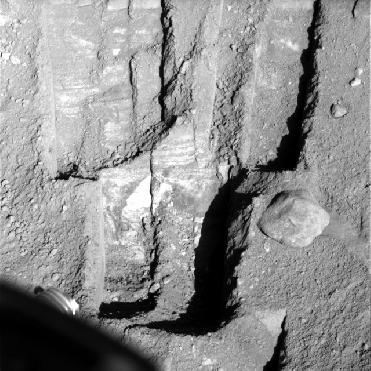
TUCSON, Arizona (BNS): Scientists have begun analysis of a sample of the soil delivered to NASA's Phoenix Mars Lander's wet chemistry experiment from the deepest trench, dug so far, in the Martian Arctic plains. Phoenix has also been observing the movement of overhead clouds.
The Lander's robotic arm, on Sunday, sprinkled a small fraction of the estimated 50 cubic centimeters of soil that had been scooped up from the informally named "Stone Soup" trench on Saturday, the 95th day of the mission. The Stone Soup trench, in the left portion of the Lander's active workspace, is approximately 18 cms (7 inches) deep.
“This is pretty exciting stuff and we are anxious to find out what makes this deeper soil cloddier than the other samples,” said Doug Ming, a Phoenix science team member from NASA's Johnson Space Center, Houston.
The surface of the vast Arctic plain where Phoenix landed on May 25 bears a pattern of polygon-shaped small hummocks, similar to some permafrost terrain on Earth. Scientists are particularly interested in the new sample because it is the first delivered to an analytical instrument from a trench on the margin between two of the polygons, where different materials may have collected than what has been analysed from near the center of a polygon.
A series of images of fresh soil dug and discarded from Stone Soup trench have given some clues to the composition of the sample. While spectral observations have not produced any sign of water-ice, bigger clumps of soil have shown a texture that could be consistent with elevated concentration of salts in the soil from deep in the trench. The Lander's wet chemistry laboratory can identify soluble salts in the soil.
The science team has been studying a movie created from still pictures of the nearby Martian sky showing dramatic water ice clouds moving over the landing site during a 10-minute period on Sol 94 (August 29).
“The images were taken as part of a campaign to see clouds and track wind. These are clearly ice clouds,” said Mark Lemmon, the lead scientist for the Lander's surface stereo imager, from Texas A&M University.
The Phoenix mission is led by Peter Smith at The University of Arizona with project management at NASA's Jet Propulsion Laboratory in Pasadena, Calif., and development partnership at Lockheed Martin in Denver. International contributions come from the Canadian Space Agency; the University of Neuchatel, Switzerland; the universities of Copenhagen and Aarhus in Denmark; the Max Planck Institute in Germany; and the Finnish Meteorological Institute.
 Previous Article
Previous Article













The Indian Air Force, in its flight trials evaluation report submitted before the Defence Ministry l..
view articleAn insight into the Medium Multi-Role Combat Aircraft competition...
view articleSky enthusiasts can now spot the International Space Station (ISS) commanded by Indian-American astr..
view article